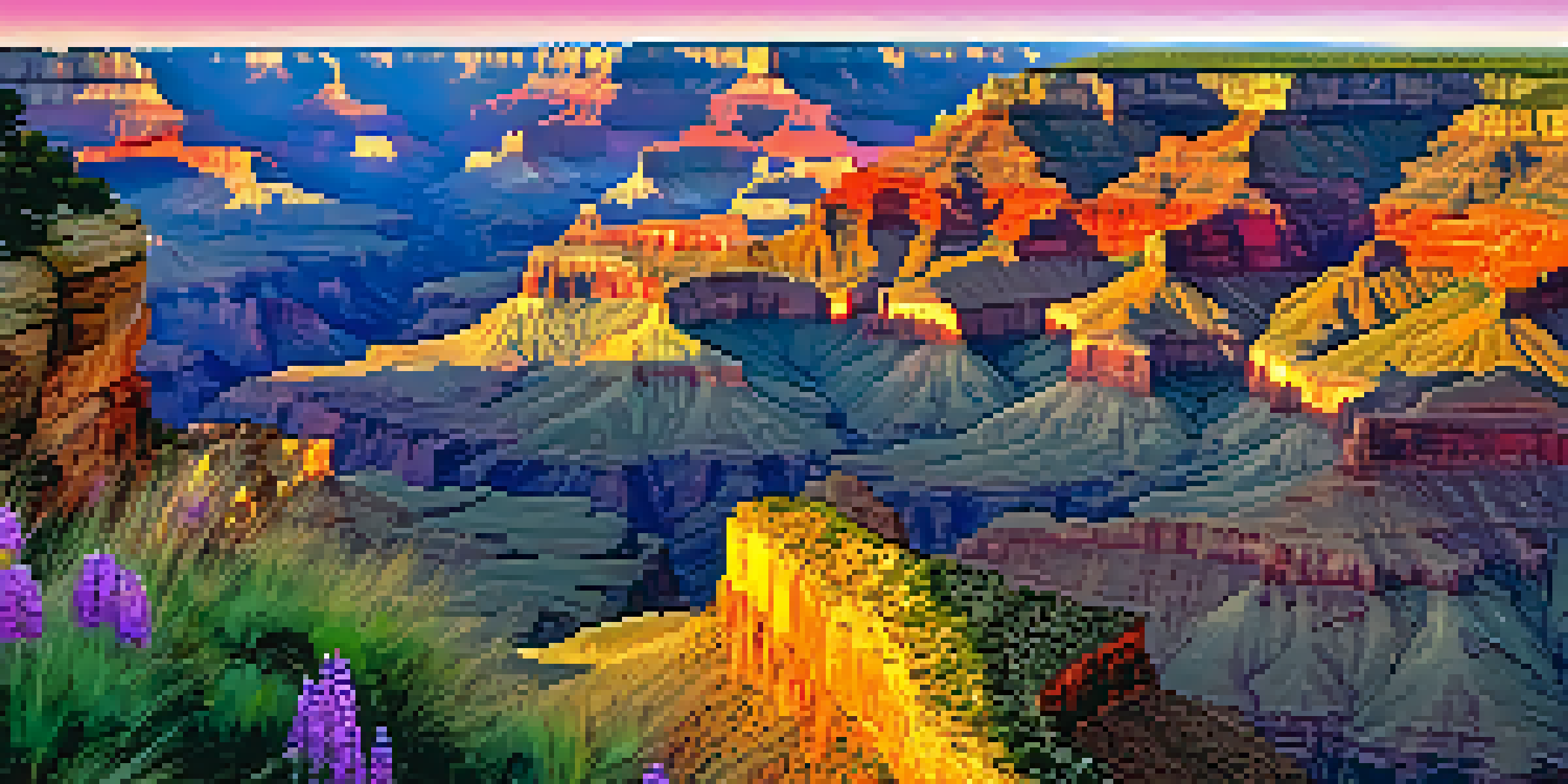Arizona's Role in Shaping America's National Parks Legacy

The Birth of the National Park Movement in Arizona
In the early 20th century, Arizona emerged as a focal point for the national park movement. The stunning landscapes, from the Grand Canyon to the Sonoran Desert, captivated the hearts of conservationists. These natural wonders inspired a growing awareness of the need to preserve America's wild spaces for future generations.
In every walk with nature one receives far more than he seeks.
The establishment of Grand Canyon National Park in 1919 marked a pivotal moment, showcasing Arizona's breathtaking beauty on a national stage. This park not only highlighted the importance of protecting natural landscapes but also sparked interest in the broader national park system. The Grand Canyon became a symbol, urging the government and citizens to consider the preservation of other unique environments.
Arizona's involvement didn't stop at the Grand Canyon. The state played a significant role in advocating for the creation of other national parks and monuments, including Saguaro National Park. This commitment to conservation helped lay the groundwork for a national ethos that values the protection of natural treasures.
Cultural Heritage: Indigenous Influence on National Parks
Arizona's national parks are not just about stunning vistas; they are rich in cultural heritage. The lands now protected as parks were once home to Indigenous peoples who lived in harmony with the environment for centuries. Their traditions, stories, and stewardship practices offer invaluable insights into sustainable living.

Many national parks in Arizona, such as Canyon de Chelly and Monument Valley, hold deep cultural significance for Native American tribes. These parks are not merely recreational spaces; they are sacred sites that reflect the history and beliefs of the Indigenous communities. Recognizing this heritage enriches the visitor experience and fosters respect for the land.
Arizona's Parks Highlight Biodiversity
Arizona's national parks showcase diverse ecosystems that support an impressive variety of plant and animal species, emphasizing the importance of conservation.
The collaboration between Indigenous tribes and the National Park Service has led to the incorporation of tribal knowledge in park management. This partnership emphasizes the importance of honoring the past while ensuring that future generations can enjoy and learn from these remarkable landscapes.
Unique Ecosystems: Arizona's Biodiversity in National Parks
Arizona's diverse ecosystems contribute significantly to the overall biodiversity of America's national parks. From the arid deserts to the lush forests of the high country, the state's parks showcase a range of habitats that support an impressive variety of plant and animal species. This biological richness is a treasure not just for Arizona, but for the entire nation.
The earth has music for those who listen.
Take Saguaro National Park, for instance, which is home to the iconic saguaro cactus and numerous wildlife species. The park serves as a crucial habitat for many animals, including the elusive desert tortoise and various bird species. Protecting such ecosystems is essential for maintaining ecological balance and preserving these unique species.
The interconnectivity of these ecosystems highlights the importance of conservation efforts across state lines. Arizona's national parks serve as critical refuges for wildlife, demonstrating how preserving one region can have positive effects on a larger scale, thus enhancing America's natural heritage.
Tourism and Economic Benefits of Arizona's National Parks
National parks in Arizona are not only vital for conservation; they also play a significant role in the state's economy. Millions of visitors flock to these natural wonders each year, bringing with them a boost to local businesses and tourism-related jobs. This influx of tourists contributes substantially to Arizona's economy, making the case for continued investment in park preservation.
The economic impact extends beyond just visitor spending; it involves job creation in various sectors, including hospitality, transportation, and recreation. Local communities benefit from the presence of national parks, as they foster a sense of pride and identity tied to the natural beauty surrounding them. This relationship between parks and local economies illustrates the mutual benefits of conservation and tourism.
Cultural Heritage Enriches Visitor Experience
The Indigenous heritage embedded in Arizona's national parks enhances the visitor experience, fostering respect and a deeper connection to the land.
Moreover, the funds generated through park tourism can be reinvested into park services and conservation efforts. This creates a sustainable cycle where the parks can thrive while simultaneously supporting the communities that depend on them, reinforcing the idea that protecting nature can lead to economic prosperity.
Education and Awareness: Arizona's Parks as Learning Centers
Arizona's national parks serve as educational hubs, offering visitors a chance to learn about ecology, geology, and history. Through ranger-led programs, workshops, and informational displays, visitors of all ages can engage with the natural world in meaningful ways. This educational aspect is crucial for fostering an appreciation for conservation and environmental stewardship.
For example, the Grand Canyon offers geoscience programs that help visitors understand the intricate processes that shaped this iconic landmark. By providing hands-on learning experiences, parks encourage a deeper connection between people and the environment. This knowledge can inspire individuals to become advocates for nature preservation in their own communities.
Furthermore, Arizona's parks often collaborate with schools and educational institutions to enhance learning opportunities. These partnerships not only enrich the educational experience but also cultivate a generation of environmentally conscious citizens who are invested in protecting these invaluable resources.
Challenges Facing Arizona's National Parks
Despite their beauty and importance, Arizona's national parks face several challenges. Climate change, invasive species, and increased tourism can threaten the delicate ecosystems that these parks protect. Addressing these issues is essential to ensure that Arizona's natural treasures remain intact for future generations to explore and enjoy.
For instance, the rising temperatures and changing precipitation patterns affect wildlife habitats and plant life within the parks. Invasive species can disrupt native ecosystems, leading to a decline in biodiversity. The National Park Service is actively working to mitigate these impacts through various management strategies, but ongoing support from the public is vital.
Tourism Boosts Local Economies
National parks in Arizona significantly contribute to the state's economy by attracting millions of visitors, creating jobs, and supporting local businesses.
Engaging visitors in conservation efforts and raising awareness about these challenges can foster a sense of responsibility. By becoming informed stewards of the land, individuals can contribute to the preservation of Arizona's national parks and help combat the threats they face.
The Future of Arizona's National Parks
Looking ahead, the future of Arizona's national parks holds both promise and responsibility. As awareness of environmental issues grows, there is an increasing push for sustainable practices that can help protect these landscapes. The collaboration between park officials, local communities, and visitors will be crucial in shaping a positive future for these cherished spaces.
Innovative conservation strategies, such as habitat restoration and community engagement programs, are already being implemented to enhance the resilience of Arizona's parks. These initiatives aim to address current challenges while ensuring that the parks remain accessible and enjoyable for everyone. The continued investment in preserving these natural wonders is a testament to their significance.

Ultimately, the legacy of Arizona's national parks lies in our hands. By fostering a culture of appreciation and responsibility, we can ensure that future generations experience the awe and inspiration that these landscapes provide. The journey towards a sustainable future for Arizona's national parks is a shared responsibility, one that invites everyone to participate.